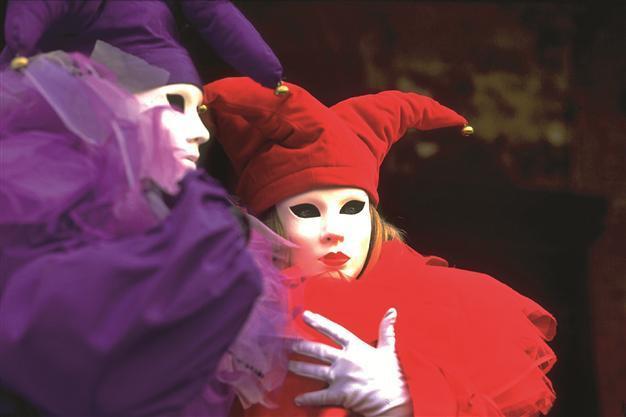A Taste of Two Cities: La Serenissima & La Sublime Porta
AYLİN ÖNEY TAN - aylin.tan@hdn.com.tr
 The Carnival of Venice has just started and it is time to celebrate the tastes of two cities; Venice, the serene port of peace, and Istanbul, the sublime gate to happiness. Like two long-separated sisters, both cities have much in common.
The Carnival of Venice has just started and it is time to celebrate the tastes of two cities; Venice, the serene port of peace, and Istanbul, the sublime gate to happiness. Like two long-separated sisters, both cities have much in common. The fascinating story of Alvise Gritti tells much about the tale of two cites. It is incredible how the “bastardo” of Venice turned out to be regarded as a prince in Istanbul. The two cities have shared much history, and Alvise Gritti must be one vivid character to have been influential in both, leading a remarkably adventurous life. Alvise was the illegitimate son of Andrea Gritti, the Dodge of Venice elected in 1523. He was born in Istanbul of an Ottoman-Greek mother, educated in Ravenna and Venice, but despite his talent and good education, he had no chance of a career in Venice. Being a “bastard,” he was deprived of the right to participate in politics in Venice. He took his chances making a profit from his dual cultural background and embarked on a new life in his birthplace of Istanbul, demonstrating his talents in commerce, diplomacy and politics. He was introduced to Sultan Suleyman the Magnificent through Grand Vizier Ibrahim Pasha and quickly switched from a trader to a dragoman and consultant, acting as a mediator between the Ottoman court and European states.
Naturally, he had a taste for both cities, was fluent in their languages and dialects, and knew exactly what was needed most. He made a fortune supplying the staple grain of wheat to Venice from bountiful Anatolia, and other commodities like salt and luxury items like good quality saffron and wine.
His wealth was legendary in Istanbul, his home was a Venetian-style “Seraglio” in Pera, the district now also known as Beyoğlu. Sadly, the building did not survive to this day, as the Italian Embassy “Venedik Sarayı” was built in its place.
Alvise Gritti, the little bastard son of the Dodge, grew to a prince-like character in Istanbul, nicknamed Bey-Oglu, meaning son of the noble man. He had such an influence in shaping the lifestyle of Pera in his time that the whole district became known as his territory, hence the neighborhood’s name, Beyoğlu. He was also in a way a trendsetter in Venice, starting the fashion of “Cose de’Turchi.”
Anything Turkish was the way to go in clothes, in music and in food. The trade house Fondaco dei Turchi just near the Rialto Bridge was full of Ottoman merchants from Istanbul, and surely the smell of the food they cooked and brought along invaded the Venetian canals. It had been recorded that a number of cooks were brought from the sublime city to the canals of La Serenissima. Venetian historian Antonio Fabris suggests that Istanbul tastes have greatly influenced Venetian cooking. A touch of sugar in dishes steeped in olive oil, a sprinkle of cinnamon, a handful of currants and pine nuts in savory dishes, a splash of sour here and there, all reflect a common taste palette. Venetians and Istanbulites also have a soft spot for imbibing on every occasion possible. Venetians have a bite of “cicheto” with their wine, while it is the custom to have a fork of “meze” with rakı. Every year the carnival opens with the flight of the Turk, “Volo del Turco,” named after the first young Turk who had the courage to slide down a rope from the Campanile to the San Marco square. I’m sure after a couple of glasses many young Venetians and Istanbulites may still have the courage to jump into the Grand Canal or Bosphorous, so cheers to the Carnival and celebrate the common heritage with food!
Recipe of the Week:
Venetians and Istanbulites have a love for seafood, especially for those tiny fish that pour from fishermen’s nets like mother-of-pearl flakes. Venetian specialty Sarde’le in Saor has strong oriental influences that would easily find its place on an Istanbul table. Dust one kilo of cleaned, butterflied sardines in one cup of flour, and fry in batches in good olive oil. Meanwhile, halve and thinly slice one kilogram of onions, sautee in half a cup of olive oil adding one handful each of currants and pine nuts, with one teaspoon of sugar, half a teaspoon each of cinnamon, allspice, salt and pepper. When the onions are limp and soft, almost slightly golden but not brown, add one cup of apple or white wine vinegar and let simmer, reducing all juices. Arrange fried sardines in a deep serving dish, sprinkle with salt and cover with the sauteed onion. Cover and put in the fridge overnight.
Bite of the week
Fork of the Week:
If you want to go out and try some Italian tastes, the Four Seasons Hotel Bosphorous will be hosting Michelin-starred Italian chef Vito Mollica of Palladio Hotel in Florence in February. Another way to splurge is, of course, to go to Venice and join the crowds, preferably staying in Hotel Cipriani, famous for its unmatched service, now owned by the Orient Express group, named for the legendary train that once connected the two cities.
Cork of the Week:
The ideal choice to toast a “Brindisi” or raise glasses to a “Şerefe” would be a glass of Prosecco! Ruffino Prosecco is imported to Turkey by Kayra group and it will match perfectly with your Venetian sardines alla Turca.












